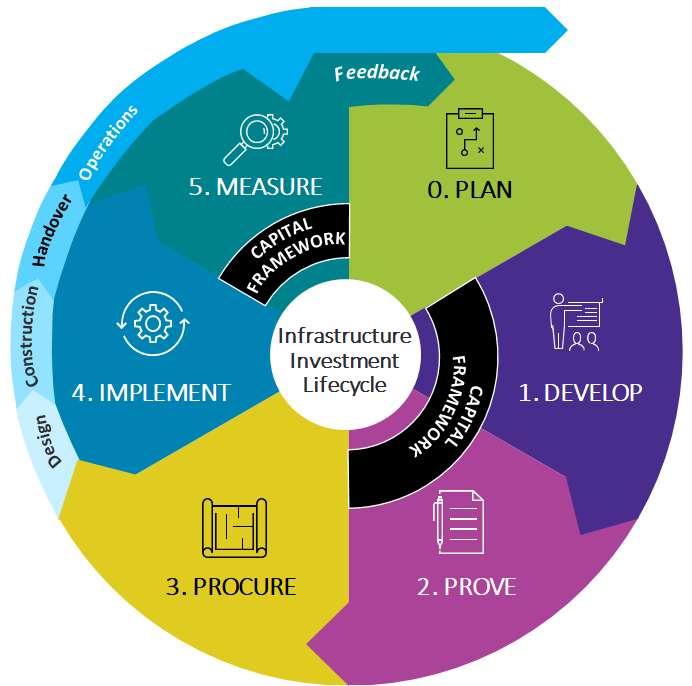Capital Framework
The Capital Framework is the policy framework used by the Territory to support the successful delivery of capital projects in the ACT. It is managed by Infrastructure and Commercial Advice (ICA) in Treasury and provides consistent, structured and fit-for-purpose guidance to support you in methodically undertaking robust analysis of infrastructure projects and help inform Government in making investment decisions, tracking outcomes and benefits.
Capital Framework within the Infrastructure Investment Lifecycle
The Infrastructure Investment Lifecycle is the staged lifecycle of an investment - from planning, proposing and delivering investments, together with measuring their benefits in practice and feeding lessons learnt to future projects.
The Capital Framework covers Stage 1 - Develop, Stage 2 - Prove and Stage 5 - Measure of the Infrastructure Investment Lifecycle.
Although the Capital Framework does not cover Stage 3 - Procure and Stage 4 – Implement, it has intrinsic implications for these stages, particularly in relation to the monitoring and reporting of risk, contingency and benefits realisation. Procurement ACT supports the activities within Stage 3 - Procure. Infrastructure Canberra (iCBR) administers the Project Delivery Framework which supports Agencies through Stage 3 – Procure and Stage 4 – Implement. For more information on the Project Delivery Framework contact the iCBR Project Management Office.

|
Stage 0 - Plan This stage is not covered by the Capital Framework but has intrinsic implications as it involves the agency identifying and planning its strategic service need. |
|
Stage 1 - Develop Formally covered by the Capital Framework. Agencies undertake analysis as well as early consultation with Treasury and iCBR to identify the problem or opportunity that needs to be addressed and the benefits that will result. |
|
Stage 2 - Prove Formally covered by the Capital Framework. This involves detailed assessment of the need for investment and resulting benefits. A business case is developed through analysing options, determining scope and identifying the recommended project option. This may include initial design development to enable a robust estimate of cost and delivery timeline. |
|
Stage 3 - Procure Supported by Procurement ACT as well as within iCBR’s Project Delivery Framework. This involves procuring the project and considers the project’s readiness for issue to market and value for money outcomes. Treasury can provide support where appropriate (e.g. participation project boards, tender evaluation). Although this stage is not covered by the Capital Framework it has intrinsic implications. |
|
Stage 4 - Implement Supported by Infrastructure Canberra within its Project Delivery Framework. This involves finalising the design, constructing the project, and putting it into operation. Treasury can provide support where appropriate (e.g. participation project boards). Although this stage is not covered by the Capital Framework it has intrinsic implications. |
|
Stage 5 - Measure Formally covered by the Capital Framework. This involves assessing the project’s processes and outcomes, including monitoring and reporting on benefits realisation, and feeding back lessons learnt to future projects. |

